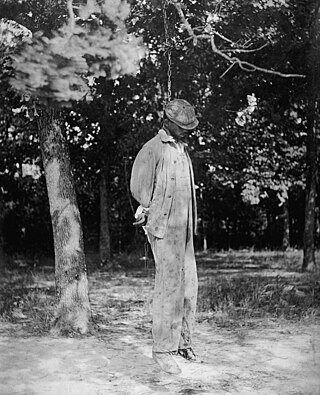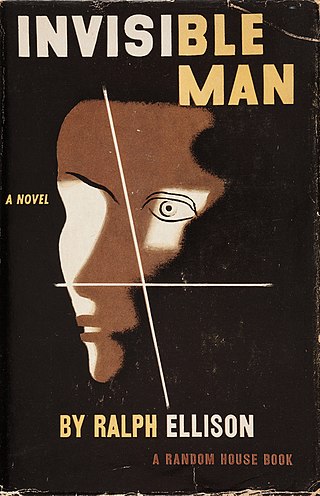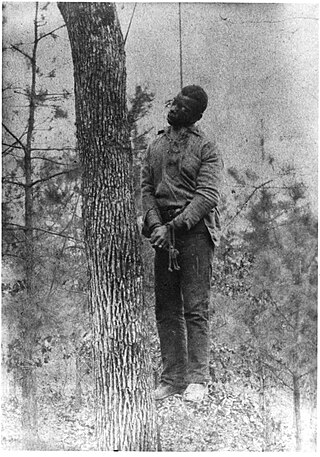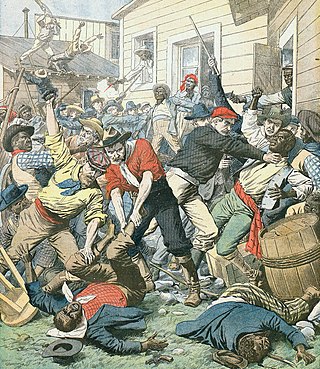
Lynching is an extrajudicial killing by a group. It is most often used to characterize informal public executions by a mob in order to punish an alleged transgressor, punish a convicted transgressor, or intimidate people. It can also be an extreme form of informal group social control, and it is often conducted with the display of a public spectacle for maximum intimidation. Instances of lynchings and similar mob violence can be found in every society.

Invisible Man is a novel by Ralph Ellison, published by Random House in 1952. It addresses many of the social and intellectual issues faced by African Americans in the early twentieth century, including black nationalism, the relationship between black identity and Marxism, and the reformist racial policies of Booker T. Washington, as well as issues of individuality and personal identity.

The Omaha Race Riot occurred in Omaha, Nebraska, September 28–29, 1919. The race riot resulted in the lynching of Will Brown, a black civilian; the death of two white rioters; the injuries of many Omaha Police Department officers and civilians, including the attempted hanging of Mayor Edward Parsons Smith; and a public rampage by thousands of white rioters who set fire to the Douglas County Courthouse in downtown Omaha. It followed more than 20 race riots that occurred in major industrial cities of the United States during the Red Summer of 1919.

Lynching was the widespread occurrence of extrajudicial killings which began in the United States' pre–Civil War South in the 1830s and ended during the civil rights movement in the 1950s and 1960s. Although the victims of lynchings were members of various ethnicities, after roughly 4 million enslaved African Americans were emancipated, they became the primary targets of white Southerners. Lynchings in the U.S. reached their height from the 1890s to the 1920s, and they primarily victimised ethnic minorities. Most of the lynchings occurred in the American South because the majority of African Americans lived there, but racially motivated lynchings also occurred in the Midwest and border states.

J. Thomas Shipp and Abraham S. Smith were young African-American men who were murdered in a spectacle lynching by a mob of thousands on August 7, 1930, in Marion, Indiana. They were taken from jail cells, beaten, and hanged from a tree in the county courthouse square. They had been arrested that night as suspects in a robbery, murder and rape case. A third African-American suspect, 16-year-old James Cameron, had also been arrested and narrowly escaped being killed by the mob; an unknown woman and a local sports hero intervened, and he was returned to jail. Cameron later stated that Shipp and Smith had committed the murder but that he had run away before that event.

Uncle Tom's Children is a collection of novellas and the first book published by African-American author Richard Wright, who went on to write Native Son (1940), Black Boy (1945), and The Outsider (1953). When it was first published in 1938, Uncle Tom's Children included only four novellas: "Big Boy Leaves Home," "Down by the Riverside," "Long Black Song," and "Fire and Cloud." "The Ethics of Living Jim Crow" and "Bright and Morning Star," which are now the first and final pieces, respectively, were added when the book was republished in 1940. The book's title is derived from Harriet Beecher Stowe's Uncle Tom's Cabin, an anti-slavery novel published in 1852.

The Pickens County Courthouse in the county seat of Carrollton, Alabama is the courthouse for Pickens County, Alabama. Built-in 1877-1878 as the third courthouse in the city, it is noted for a ghostly image that can be seen in one of its garret windows. This is claimed to be the face of freedman Henry Wells from 1878.
Roy Belton was a 19-year-old white man arrested in Tulsa, Oklahoma with a female accomplice for the August 21, 1920 hijacking and shooting of a white man, local taxi driver Homer Nida. He was taken from the county jail by a group of armed men, after a confrontation with the sheriff, and taken to an isolated area where he was lynched.

Henry Smith was an African-American youth who was lynched in Paris, Texas. Smith allegedly confessed to murdering the three-year-old daughter of a law enforcement officer who had allegedly beaten him during an arrest. Smith fled, but was recaptured after a nationwide manhunt. He was then returned to Paris, where he was turned over to a mob and burned at the stake. His lynching was covered by The New York Times and attracted national publicity.
In Forsyth County, Georgia, in September 1912 two separate alleged attacks on white women resulted in black men being accused as suspects. One white woman accused two black men of breaking into her home in Big Creek Community and one of raping her. Another teenage woman was fatally beaten and raped in the Oscarville Community. Earnest Knox was linked to the Oscarville murder along with his half brother by a hair comb sold to him at the Oscarville store. When confronted, he confessed to the Sheriff and implicated his half brother and mother’s live-in boyfriend. His mother testified against the sons during the jury trial which sentenced both to hanging. 21 days later the sentence was carried out.
Claude Neal was a 23-year-old African-American farmhand who was arrested in Jackson County, Florida, on October 19, 1934, for allegedly raping and killing Lola Cannady, a 19-year-old white woman missing since the preceding night. Circumstantial evidence was collected against him, but nothing directly linked him to the crime. When the news got out about his arrest, white lynch mobs began to form. In order to keep Neal safe, County Sheriff Flake Chambliss moved him between multiple jails, including the county jail at Brewton, Alabama, 100 miles (160 km) away. But a lynch mob of about 100 white men from Jackson County heard where he was, and brought him back to Jackson County.

On Tuesday, November 12, 1914, John Evans, a black man, was lynched in St. Petersburg, Florida, United States, by a mob of 1,500 white men, women and children. Evans was accused of the murder of Edward Sherman, a white real estate developer, and the attack of Sherman's wife, Mary. After word of the attack spread, and Mary Sherman claimed her attackers were "two negroes," a citywide search ensued. Suspicions immediately led to John Evans. Two days after the murder, a posse consisting of some of the city's most prominent and well-respected members stormed the St. Petersburg jail, threw a noose around Evans' neck and marched him to his death. He was never given a fair trial. Evans was hanged from a light post on the corner of Ninth Street South and Second Avenue. At first, he kept himself alive by wrapping his legs around the light pole. An unidentified white woman in a nearby automobile ended his struggle with a single bullet. Though the shot was fatal, the rest of the crowd began shooting at Evans' dangling body until their ammunition was depleted.

The Perry massacre was a racially motivated conflict in Perry, Florida, in December 1922. Whites killed four black men, including Charles Wright, who was lynched by being burned at the stake, and they also destroyed several buildings in the black community of Perry after the murder of Ruby Hendry, a white female schoolteacher.
The lynching of the Frenches of Warsaw took place in Warsaw, Gallatin County, Kentucky on May 3, 1876, between 1 am and 2 am on a Wednesday morning. Benjamin and Mollie French, African Americans, were lynched by a white mob for the murder of another African American, which was unusual for this period. Lake Jones was an elderly black man who had faithfully served a white family named Howard, both before and after his emancipation from slavery. The Frenches were accused of poisoning Lake Jones with arsenic and intending to steal his money.
Matthew Williams was a black man lynched by a white mob in Salisbury, Maryland on December 4, 1931.

Jim McIlherron was an African-American man who was tortured and executed by a lynch mob on February 12, 1918, in Estill Springs, Tennessee. McIlherron was lynched in retaliation for shooting and killing two white men after a fight broke out.
Leonard Woods was an African-American man who was lynched by a mob in Pound Gap, on the border between Kentucky and Virginia, after they broke him out of jail in Whitesburg, Kentucky, on November 30, 1927. Woods was alleged to have killed the foreman of a mine, Herschel Deaton. A mob of people from Kentucky and Virginia took him from the jail and away from town and hanged him, and riddled his body with shots. The killing, which became widely publicized, was the last in a long line of extrajudicial murders in the area, and, prompted by the activism of Louis Isaac Jaffe and others, resulted in the adoption of strong anti-lynching legislation in Virginia.
Lation (Ligon) Scott was an African American lynching victim suspected of raping a white woman in Dyer County, Tennessee. Scott was tortured, mutilated and burned alive by a mob on Sunday, December 2, 1917 in downtown Dyersburg.
Luther Holbert was an African American man who was tortured and lynched by a mob in Doddsville, Mississippi on Sunday, February 7, 1904, after being accused of a double murder. An African American woman who was with Holbert was also tortured and killed. Six other people were also killed during the search for Holbert and the woman.










